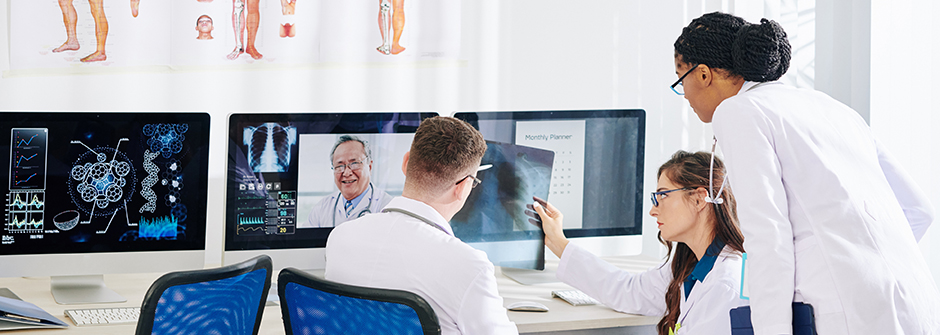
IPE Journey of Professional Transformation
Primary care providers, consultants and specialists, nurses, therapists, pharmacists and other professionals in various settings including hospitals, doctor’s offices, nursing homes, rehabilitation centers, school systems and athletic programs, often work together to provide care for each person. While team-based healthcare is not a novel concept and the benefits of teamwork in healthcare have been described (Grumbach & Bodenheimer, 2004; Institute of Medicine, 2015), interprofessional education and practice has not been consistent across the healthcare continuum (Institute of Medicine, 2015). To achieve the vision for person-centered care and optimal outcomes, it is essential to enhance interprofessional competencies through assessment and development of teamwork behaviors (Interprofessional Education Collaborative, 2016; World Health Organization, 2010).
Formal interprofessional education (IPE) during the professional phase of student education has emerged as the means to provide students with the opportunity to advance their skills in teamwork, communication, collaboration and the understanding of ethics (Zipp et al., 2021).
Interprofessional education allows for “opportunities for awareness, appreciation, and development of one’s professional identity as well as an appreciation of the interdependence that exists among professionals” within health education programs (Zipp et al., 2014, p. 25).
The World Health Organization (WHO) (2010) developed the Framework for Action on Interprofessional Education & Collaborative Practice, which called for various stakeholders, including policymakers, educators, healthcare employees and leaders in the community to embed IPE and collaborative practice into healthcare services. The Interprofessional Education Collaborative (2016) subsequently developed and updated an organizing framework comprised of four core competencies for Interprofessional Collaboration of: 1) Values/Ethics for Interprofessional Practice, 2) Roles/Responsibilities, 3) Interprofessional Communication, and 4) Teams and Teamwork, to guide curricular development in the area of IPE. This IPE framework provides a lens which the Academy can use to assist them in preparing students to meet the holistic needs of their patients/clients and across practice settings (Zipp et al., 2021).
Health science students in the School of Health and Medical Sciences (SHMS) at Seton Hall University (SHU), engage in both comprehensive and rigorous program-specific curriculums and a schoolwide interprofessional education (IPE) curriculum termed the “Journey of Professional Transformation” which is guided by the IPE framework (Zipp et al., 2021). The “Journey” uses a structured immersion curricular design consisting of participation in five synchronous Core Signature IPE Experiences and four online, asynchronous IPE Modules which are offered by the schools’ Center for Interprofessional Education and Health Sciences (CIEHS). These longitudinal learning experiences have been carefully developed to support and enhance students’ understanding and appreciation of the interdependency that exists among healthcare professionals when engaging in person centered care, while further emphasizing their individual roles as part of the healthcare team (Zipp et al., 2021). Each experience focuses on a prevalent topic of interest in healthcare and is designed to broaden students’ understanding of the topic while they learn with and from each other about the common issues within their fields.
Students from each program in the School of Health and Medical Sciences (SHMS) participate in all aspects of the Journey of Professional Transformation. These post-baccalaureate programs include Athletic Training (AT), Occupational Therapy (OT), Physical Therapy (PT), Physician Assistant (PA), Speech-Language Pathology (SLP), and Master of Healthcare Administration (MHA).
Each program at SHMS is accredited, and bound by accreditation standards which require that students receive professionalism training and interprofessional education during the course of their curriculum as follows: Accreditation Council for Occupational Therapy Education (ACOTE) (n.d.); Accreditation Review Commission on Education for the Physician Assistant, Inc. (ARC-PA) (n.d.); Commission on Accreditation of Athletic Training Education (CAATE), (n.d.); Commission on Accreditation in Physical Therapy Education (CAPTE) (2020); Council on Academic Accreditation in Audiology and Speech-Language Pathology (CAA) (2020); Commission on Accreditation of Healthcare Management Education (CAHME) (2021). The fact that each profession specifically lists these related requirements in their standards of accreditation indicates the importance of IPE and professionalism in educating healthcare students.
Core Signature IPE Experiences
The Core Signature IPE Experiences begin during SHMS’ orientation with Core 1. These five synchronous group immersion events progress longitudinally once per semester over the next two academic years, ending with Core 5 in the second year of the SHMS students’ professional programs. Graduate students at comparable points in their didactic education from the College of Nursing at Seton Hall University and a School of Pharmacy in NJ also participate in several of the Core Experiences. Table 1 outlines the Core Signature IPE Experiences and timeframes for delivery.
Table 1
| Core Signature IPE Experiences | Core Experience Topic Year/Semester |
| Core 1 Journey to Patient Centered Care Orientation | First year/Fall semester |
| Core 2 Medical Errors and Team STEPPS | First year/Fall semester |
| Core 3 Fostering an Inclusive Athletics Environment | First year/Spring semester |
| Core 4 Parent Perspective | Second year/Fall semester |
| Core 5 Community Partnership | Second year/Spring semester |
IPE Module Experiences
The School of Health and Medical Sciences at Seton Hall University offers a total of four, online, asynchronous IPE Modules over a two-year period, which are interspersed among the Core Signature IPE Experiences. One Module is completed per semester and students from the various SHMS health professional programs are randomly assigned to interprofessional groups consisting of 10 to 15 students per group. The interprofessional Module sections are assigned at the start of the students’ academic careers at SHU, and students remain in the same section throughout their journey to provide ample opportunities to learn from, with, and about each other (Interprofessional Education Collaborative, 2016; WHO, 2010). While Module content is presented in an asynchronous format, interprofessional student teams engage consistently throughout the learning experiences, and are responsible for collaboratively completing and submitting team-based deliverables for each Module. Table 2 summarizing the IPE Module experiences.
Table 2
| IPE Module Experiences | Module Topic Year/Semester |
| Module 1 Professional Behavior | First year/Fall semester |
| Module 2 Cultural Competency | First year/Spring semester |
| Module 3 Team Science - Evidence Based Research Teams | Second year/Fall semester |
| Module 4 Healthcare Issues and Trends | Second year/Spring semester |

